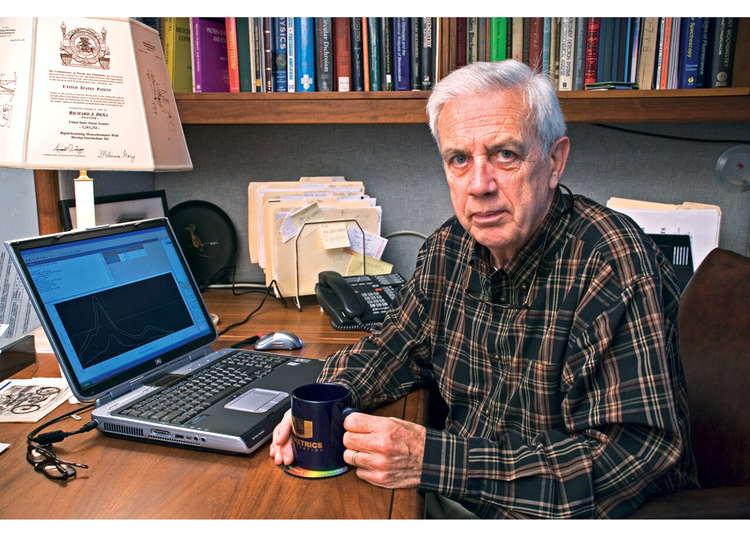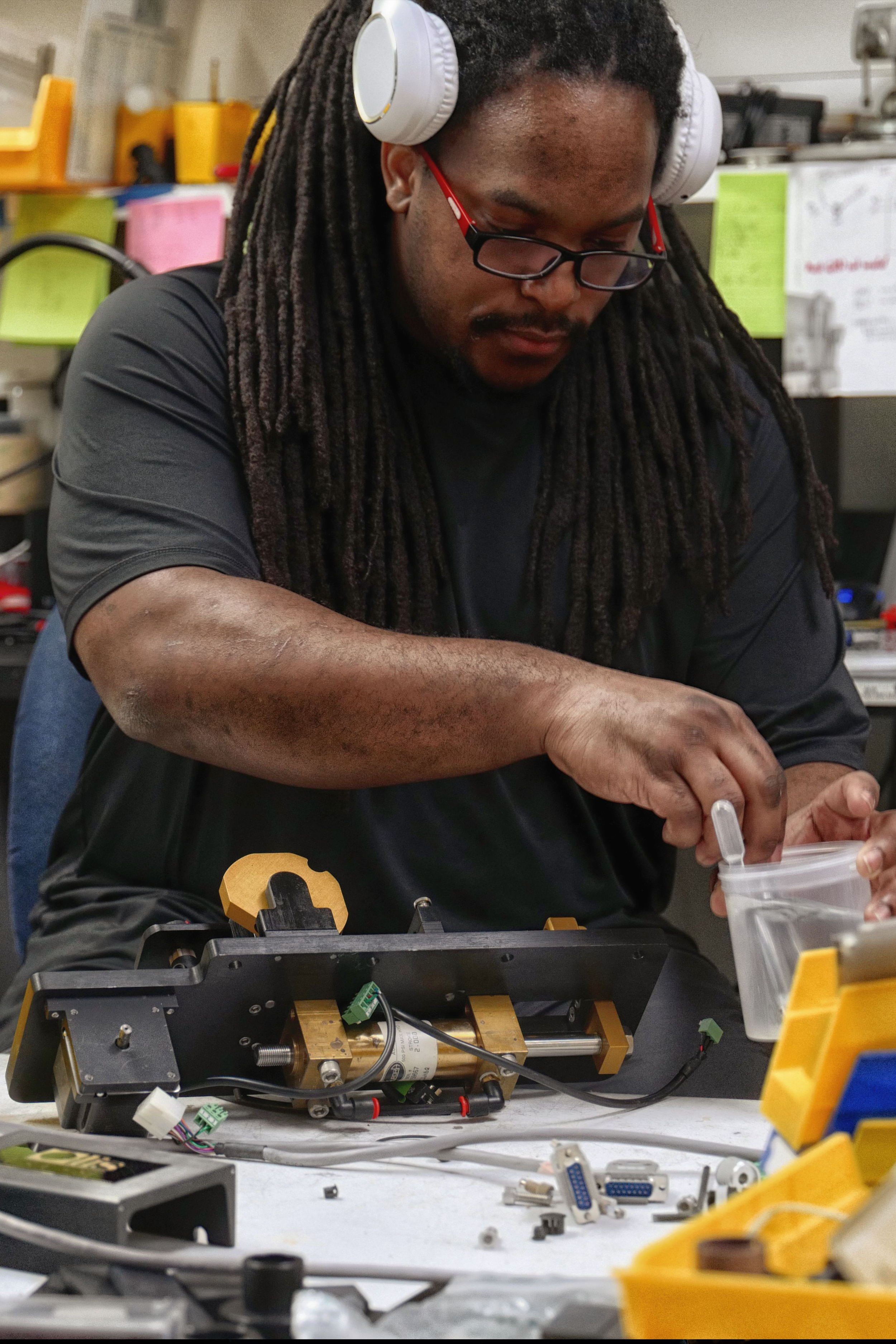Excitement About Circular Dichroism
Wiki Article
3 Easy Facts About Spectrophotometers Explained
Table of ContentsExcitement About Circularly Polarized LuminescenceIndicators on Circularly Polarized Luminescence You Should KnowThe smart Trick of Spectrophotometers That Nobody is Talking AboutAll about SpectrophotometersWhat Does Circular Dichroism Do?9 Simple Techniques For Circular DichroismGetting My Uv/vis To WorkThe 7-Second Trick For SpectrophotometersFacts About Circularly Polarized Luminescence UncoveredThe Best Strategy To Use For Uv/visFascination About Uv/visAn Unbiased View of Uv/visUnknown Facts About Spectrophotometers
It is then scanned through the sample and the reference services. Fractions of the event wavelengths are sent through, or shown from, the sample and the referral. Electronic circuits convert the relative currents into direct transmission percentages and/or absorbance/concentration values.The transmission of a referral substance is set as a standard (information) value, so the transmission of all other substances are recorded relative to the preliminary "zeroed" compound. The spectrophotometer then transforms the transmission ratio into 'absorbency', the concentration of particular components of the test sample relative to the initial substance.
Considering that samples in these applications are not readily offered in big quantities, they are particularly matched to being evaluated in this non-destructive method. In addition, valuable sample can be conserved by making use of a micro-volume platform where as little as 1u, L of sample is needed for complete analyses. A short explanation of the treatment of spectrophotometry consists of comparing the absorbency of a blank sample that does not contain a colored substance to a sample which contains a colored compound.
Some Known Details About Circularly Polarized Luminescence
In biochemical experiments, a chemical and/or physical home is picked and the treatment that is utilized specifies to that property in order to derive more info about the sample, such as the amount, pureness, enzyme activity, etc. Spectrophotometry can be utilized for a number of strategies such as figuring out optimum wavelength absorbance of samples, figuring out optimal p, H for absorbance of samples, determining concentrations of unknown samples, and figuring out the p, Ka of numerous samples.: 21119 Spectrophotometry is likewise a practical procedure for protein filtration and can likewise be utilized as a method to develop optical assays of a substance.It is possible to know the concentrations of a 2 element mixture utilizing the absorption spectra of the basic solutions of each part. To do this, it is essential to understand the extinction coefficient of this mixture at two wave lengths and the extinction coefficients of services which contain the known weights of the 2 parts.

Not known Facts About Uv/vis/nir
Many spectrophotometers are used in the UV and visible areas of the spectrum, and a few of these instruments also run into the near-infrared area also. The concentration of a protein can be estimated by measuring the OD at 280 nm due to the existence of tryptophan, tyrosine and phenylalanine (http://connect.releasewire.com/company/olis-clarity-343997.htm).Nucleic acid contamination can also interfere. This method requires a spectrophotometer capable of measuring in the UV area with quartz cuvettes.: 135 Ultraviolet-visible (UV-vis) spectroscopy includes energy levels that delight electronic transitions. Absorption of UV-vis light thrills particles that are in ground-states to their excited-states. Noticeable region 400700 nm spectrophotometry is utilized thoroughly in colorimetry science.
These curves can be used to check a brand-new batch of colorant to inspect if it makes a match to specifications, e
Traditional visible region spectrophotometers can not detect if find colorant or the base material has product. This can make it difficult to manage color concerns if for example one or more of the printing inks is fluorescent. There are 2 major setups for visual spectrum spectrophotometers, d/8 (round) and 0/45.
Scientists use this instrument to determine the quantity of substances in a sample. In the case of printing measurements two alternative settings are frequently utilized- without/with uv filter to manage better the impact of uv brighteners within the paper stock.
A Biased View of Circularly Polarized Luminescence
Some applications require little volume measurements which can be carried out with micro-volume platforms. As described in the applications area, spectrophotometry can be used in both qualitative and quantitative analysis of DNA, RNA, and proteins. Qualitative analysis can be used and spectrophotometers are utilized to record spectra of compounds by scanning broad wavelength areas to identify the absorbance homes (the intensity of the color) of the substance at each wavelength.
Little Known Questions About Uv/vis/nir.
One significant aspect is the type of photosensors that are available for different spectral areas, but infrared measurement is also difficult because virtually whatever produces IR as thermal radiation, particularly at wavelengths beyond about 5 m. Another issue is that many products such as glass and plastic soak up infrared, making it incompatible as an optical medium.Obtained Dec 23, 2018. Essential Lab Methods for Biochemistry and Biotechnology (2nd ed.). The essential guide to analytical chemistry.
Chichester, NY: Wiley. pp. 1617. ISBN 9780471974123. OCLC 36543293. Ninfa AJ, Ballou DP (2004 ). Fundamental laboratory approaches for biochemistry and biotechnology. Hoboken: Wiley. p. 66. ISBN 9781891786006. OCLC 633862582. Rendina G (1976 ). Philadelphia, PA: W. B. Saunders Company. pp. 46-55. ISBN 0721675506. OCLC 147990. Oke, J. B.; Gunn, J. E.
How Circular Dichroism can Save You Time, Stress, and Money.
"Secondary standard stars for absolute spectrophotometry". The Astrophysical Journal. 266: 713. Bibcode:1983 Ap, J..266..713 O. doi:10. 1086/160817. Ishani, G (2006 ). "The very first industrial UV-vis spectrophotometer". p. 100. Recovered Dec 23, 2018. Simoni, RD; Hill, RL; Vaughan, M; Tabor, H (Dec 5, 2003). "A Timeless Instrument: The Beckman DU Spectrophotometer and Its Innovator, Arnold O. 278 (49 ): e1. doi:. ISSN 1083-351X. Beckman, A. O.; Gallaway, W. S.; Kaye, W.; Ulrich, W. F. (March 1977). "History of spectrophotometry at Beckman Instruments, Inc". Analytical Chemistry. 49 (3 ): 280A300A. doi:10. 1021/ac50011a001. "Hewlett Packard: Substance Identification with HP 8450 A UV Visible Spectrophotometer". Analytical Chemistry. 51 (12 ): 1188A1189A. 1979-10-01.1021/ac50048a728. ISSN0003-2700. Ninfa AJ, Ballou DP, Benore M (2015 ). Basic Laboratory Approaches for Biochemistry and Biotechnology (3, rev. ed.). Hoboken, NJ: Wiley & Sons. p. 77. ISBN9780470924525. OCLC915641828. "Fully Automatic Double Beam - Atomic Absorption Spectrophotometer (AA 8000)". Lab Devices. Labindia Analytical Instruments Pvt. Ltd. "Spectrophotometry Applications and Principles".
5 Simple Techniques For Uv/vis
"Applied Spectrophotometry: Analysis of a Biochemical Mixture". Biochemistry and Molecular Biology Education. Journal of Biochemistry Education.The Best Guide To Uv/vis
U.S. Department of Commerce National Bureau of Standards special publication; 378. Washington, D.C.: U.S. National Bureau of Standards. p. 2. OCLC 920079.The process starts with a regulated light that illuminates the examined sample. When it comes to reflection, as this light connects with the sample, some is absorbed or emitted. The discharged light travels to the detector, which is examined, measured, and presented as industry-standard color scales and indices.
Market governing bodies generally define specific metrics for particular items, such as Tomato and Coffee indices. The streamlined mathematics appears like this: Where R is the reflection coefficient. All terms are evaluated over the visible spectrum from 400 to 700 nm. In the case of transmission, when the light engages with the sample, it is either soaked up, reflected, or transmitted.
The 45-Second Trick For Spectrophotometers
Examples include APHA (American Public Health Association) for watercolor and purity analysis, ASTM D1500 for petrochemical color analysis, edible oil indices utilized in food, and color analyses of drinks. All terms are evaluated over the visible spectrum from 400 to 700 nm.Image Credit: Matej Kastelic/ Dr. Arnold J. Beckman and his associates at the National Technologies Laboratories first invented the spectrophotometer in 1940. In 1935 Beckman established the company, and the discovery of the spectrophotometer was their most ground-breaking creation.
9 Simple Techniques For Circularly Polarized Luminescence
99% precision. Over time, researchers kept enhancing the spectrophotometer design to enhance its performance. For instance, the UV capabilities of the design B spectrophotometer were improved by replacing the glass prism with a quartz prism. Ultimately, the Model DU was created, consisting of a hydrogen light and other enhancements. This instrument was utilized in industrial labs, clinics, and chemistry and biochemistry departments.After 1984, double-beam versions of the gadget were developed. The addition of external software application with the arrangement find out this here of onscreen screens of the spectra was available in the 1990s. Typically, a spectrophotometer is made up of 2 instruments, specifically, a spectrometer and a photometer. A basic spectrophotometer consists of a light, a monochromator, a collimator for straight light beam transmission, a cuvette to place a sample, and a photoelectric detector.
Unknown Facts About Circular Dichroism
There are various types of spectrophotometers in various shapes and sizes, each with its own function or functionality. A spectrophotometer figures out how much light is reflected by chemical elements. UV/Vis. It measures the difference in light strength based on the total quantity of light presented to a sample and the quantity of light beam that travels through the sample solution
Based on the instrument's design, the sample is put in between the spectrometer and the photometer. After the light is gone through the sample, the photometer determines its intensity and displays the reading. A spectrophotometer is utilized to identify the concentration of both colorless and colored solutes in a solution. This instrument is utilized to figure out the rate of a response.
Report this wiki page